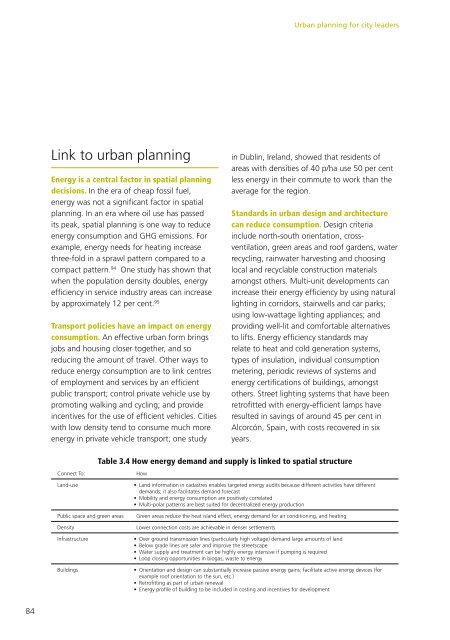Urban Planning for City Leaders - Cities Alliance
Urban Planning for City Leaders - Cities Alliance
Urban Planning for City Leaders - Cities Alliance
You also want an ePaper? Increase the reach of your titles
YUMPU automatically turns print PDFs into web optimized ePapers that Google loves.
<strong>Urban</strong> planning <strong>for</strong> city leadersLink to urban planningEnergy is a central factor in spatial planningdecisions. In the era of cheap fossil fuel,energy was not a significant factor in spatialplanning. In an era where oil use has passedits peak, spatial planning is one way to reduceenergy consumption and GHG emissions. Forexample, energy needs <strong>for</strong> heating increasethree-fold in a sprawl pattern compared to acompact pattern. 94 One study has shown thatwhen the population density doubles, energyefficiency in service industry areas can increaseby approximately 12 per cent. 95Transport policies have an impact on energyconsumption. An effective urban <strong>for</strong>m bringsjobs and housing closer together, and soreducing the amount of travel. Other ways toreduce energy consumption are to link centresof employment and services by an efficientpublic transport; control private vehicle use bypromoting walking and cycling; and provideincentives <strong>for</strong> the use of efficient vehicles. <strong>Cities</strong>with low density tend to consume much moreenergy in private vehicle transport; one studyin Dublin, Ireland, showed that residents ofareas with densities of 40 p/ha use 50 per centless energy in their commute to work than theaverage <strong>for</strong> the region.Standards in urban design and architecturecan reduce consumption. Design criteriainclude north-south orientation, crossventilation,green areas and roof gardens, waterrecycling, rainwater harvesting and choosinglocal and recyclable construction materialsamongst others. Multi-unit developments canincrease their energy efficiency by using naturallighting in corridors, stairwells and car parks;using low-wattage lighting appliances; andproviding well-lit and com<strong>for</strong>table alternativesto lifts. Energy efficiency standards mayrelate to heat and cold generation systems,types of insulation, individual consumptionmetering, periodic reviews of systems andenergy certifications of buildings, amongstothers. Street lighting systems that have beenretrofitted with energy-efficient lamps haveresulted in savings of around 45 per cent inAlcorcón, Spain, with costs recovered in sixyears.Table 3.4 How energy demand and supply is linked to spatial structureConnect To:Land-usePublic space and green areasDensityInfrastructureBuildingsHow• Land in<strong>for</strong>mation in cadastres enables targeted energy audits because different activities have differentdemands; it also facilitates demand <strong>for</strong>ecast• Mobility and energy consumption are positively correlated• Multi-polar patterns are best suited <strong>for</strong> decentralized energy productionGreen areas reduce the heat island effect, energy demand <strong>for</strong> air conditioning, and heatingLower connection costs are achievable in denser settlements• Over ground transmission lines (particularly high voltage) demand large amounts of land• Below grade lines are safer and improve the streetscape• Water supply and treatment can be highly energy intensive if pumping is required• Loop closing opportunities in biogas, waste to energy• Orientation and design can substantially increase passive energy gains; facilitate active energy devices (<strong>for</strong>example roof orientation to the sun, etc.)• Retrofitting as part of urban renewal• Energy profile of building to be included in costing and incentives <strong>for</strong> development84
















